Optimal Longitudinal Texture on Concrete Pavement to Reduce Lateral Vibration of Vehicles
Abstract
1. Introduction
2. Evaluation of Lateral Vibration of Driving Vehicles
2.1. Selection of Test Section and Method
- Movement was determined as lateral vibration regardless of X- and Z-axis movement if that along the Y-axis was considerably larger.
- Movement was determined as lateral vibration if the Y-axis movement was relatively large (though not as large as in 1), and the X- and Z-axis movements were not larger than that along the Y-axis.
2.2. Evaluation Result
3. Driving Simulation Test
4. Finite Element Analysis
- Fm: A lateral force is generated by a moment caused by the vertical load when the tire block contacts the pavement texture. The lateral force may not occur symmetrically and a greater lateral force may occur in one direction depending on the specification of the tinning groove and the lateral shifting distance. Fm represents the total lateral forces caused by a moment.
- Fs: When the tire contacts the pavement texture by load, a contact shear stress is generated depending on the specification of the tinning groove and the position of the tire. Fs denotes the total contact shear stress generated when the tire contacts the pavement texture.
5. Proposal for Optimal Longitudinal Texturing Specification
6. Conclusions
- In the field test, the panel rating survey and acceleration investigation were performed in parallel. This showed that many lateral vibrations occurred in the 3 × 3 × Random section. Among the longitudinal texture applied in unhardened concrete sections, 3 × 3 × 16 mm and 3 × 3 × 19 mm showed the best results in the panel survey and acceleration data, respectively. When grooving patterns were applied to hardened concrete, the 2 × 3 × 19 mm showed higher performance than other specifications in all tests. It was found that the NGCS specifications require further improvement in the future.
- As a result of the driving simulation test, it was analyzed that the occurrence of lateral vibration was less on the 2 × 3 × 16 mm and the 3 × 3 × 16 mm. It was found that it was clearly unfavorable to have lateral vibration in the 3 × 3 × Random section. There was no significant difference in the tinning width, but it was evaluated that a section with a 2 mm tinning width was a little advantageous for lateral vibration.
- As a result of finite element analysis, it was found that 3 × 3 × 16 mm in the case of a 3 mm tinning width and 2 × 3 × 19 mm in the case of 2 mm are most advantageous for lateral vibration. Overall, it was evaluated that the narrower the tinning width, the less the lateral vibration. It was found that the possibility of lateral vibration was high on the specifications with a wide center-to-center interval and on the random.
Author Contributions
Funding
Institutional Review Board Statement
Informed Consent Statement
Conflicts of Interest
References
- Korea Expressway Corporation. Plan for Efficient Pavement Management; Korea Expressway Corporation: Gimcheon-si, Korea, 2006. [Google Scholar]
- Korea Expressway Corporation. Method to Reduce Noise on Concrete Pavement; Korea Expressway Corporation: Gimcheon-si, Korea, 2008. [Google Scholar]
- Korea Expressway Corporation. Expressway Construction Guide Specification; Korea Expressway Corporation: Gimcheon-si, Korea, 2012. [Google Scholar]
- Korea Expressway Corporation. Analysis of Causes of Lateral Vibration on Longitudinal Tinning Section; Korea Expressway Corporation: Gimcheon-si, Korea, 2011. [Google Scholar]
- Korea Expressway Corporation. Measure to Improve Lateral Vibration in The Longitudinal Tinning Section of Expressway Concrete Pavement; Korea Expressway Corporation: Gimcheon-si, Korea, 2016. [Google Scholar]
- Kang, S.J.; Jung, K.M.; Kim, K.H. The Effect of Tire Tread Pattern and Road Designs on Groove Wander. In Proceedings of the Annual Autumn Conference and Exhibition, Korea, 24–27 November 2010. [Google Scholar]
- Korea Expressway Corporation. Guidelines for Design and Construction of Joint Concrete Pavement in Tunnels; Korea Expressway Corporation: Gimcheon-si, Korea, 2014. [Google Scholar]
- Caltrans Division of Maintenance. Diamond Grinding and Grooving. In Maintenance Technical Advisory Guide-Rigid Pavement Preservation, 2nd ed.; State of California Department of Transportation: Sacramento, CA, USA, 2007; Volume II, pp. 5-1–5-23. [Google Scholar]
- Han, J.H.; Hwang, S.W.; Kang, Y.G.; Han, M.H. The Study on the Characteristics of Groove Wandering and Noise Caused by the Design Parameter of Longitudinal Groove on the Tire’s Pattern. J. Korean Soc. Manuf. Process Eng. 2011, 10, 110–116. [Google Scholar]
- Peters, J.M. Application of the Lateral Stress Theory for Groove Wander Prediction Using Finite Element Analysis. Tire Sci. Technol. 2001, 29, 244–257. [Google Scholar] [CrossRef]
- Tarpinian, H.D.; Culp, E.H. The Effect of Pavement Grooves on the Ride of Passenger Cars—The Role of Tires. SAE Trans. 1977, 86, 2977–2985. [Google Scholar]
- Yukio, N. Prediction of Rain Groove Wandering. Vehicle System Dynamics. Int. J. Veh. Mech. Mobil. 2010, 40, 401–418. [Google Scholar]
- Doi, T.; Ikeda, K. Effect of Tire Tread Pattern on Groove Wander of Motorcycles. Tire Sci. Technol. 1985, 13, 147–153. [Google Scholar] [CrossRef]
- Oblizajek, K.L.; Lauer, N. A Laboratory Procedure for Evaluation and Diagnosis of the Interaction of Tires with Longitudinally Grooved Pavements; SAE Technical Paper Series No. 840070; SAE International: Warrendale, PA, USA, 1984. [Google Scholar]
- Robert, V.R.; Michael, A.M. Lateral Vehicle Acceleration due to Longitudinally Tined Portland Cement Concrete Pavement; CDOT-2009-13 Technical Report; Colorado Department of Transportation: Denver, CO, USA, 2019.
- Lee, D.H.; Kim, J.W.; Moon, S.H.; Jeong, W.S. Study about the Evaluation of Driving Stability Using 3-axis Accelerometer Test. J. Korean Soc. Road Eng. 2012, 14, 141–149. [Google Scholar] [CrossRef]
- Jeong, K.M.; Kang, S.J.; Kim, H.S.; Kim, K.W. Finite Element Analysis for Groove Wander Prediction of Passenger Car Tires with the Longitudinal Tread Grooves. J. Eng. 2016, 8, 11–20. [Google Scholar] [CrossRef][Green Version]
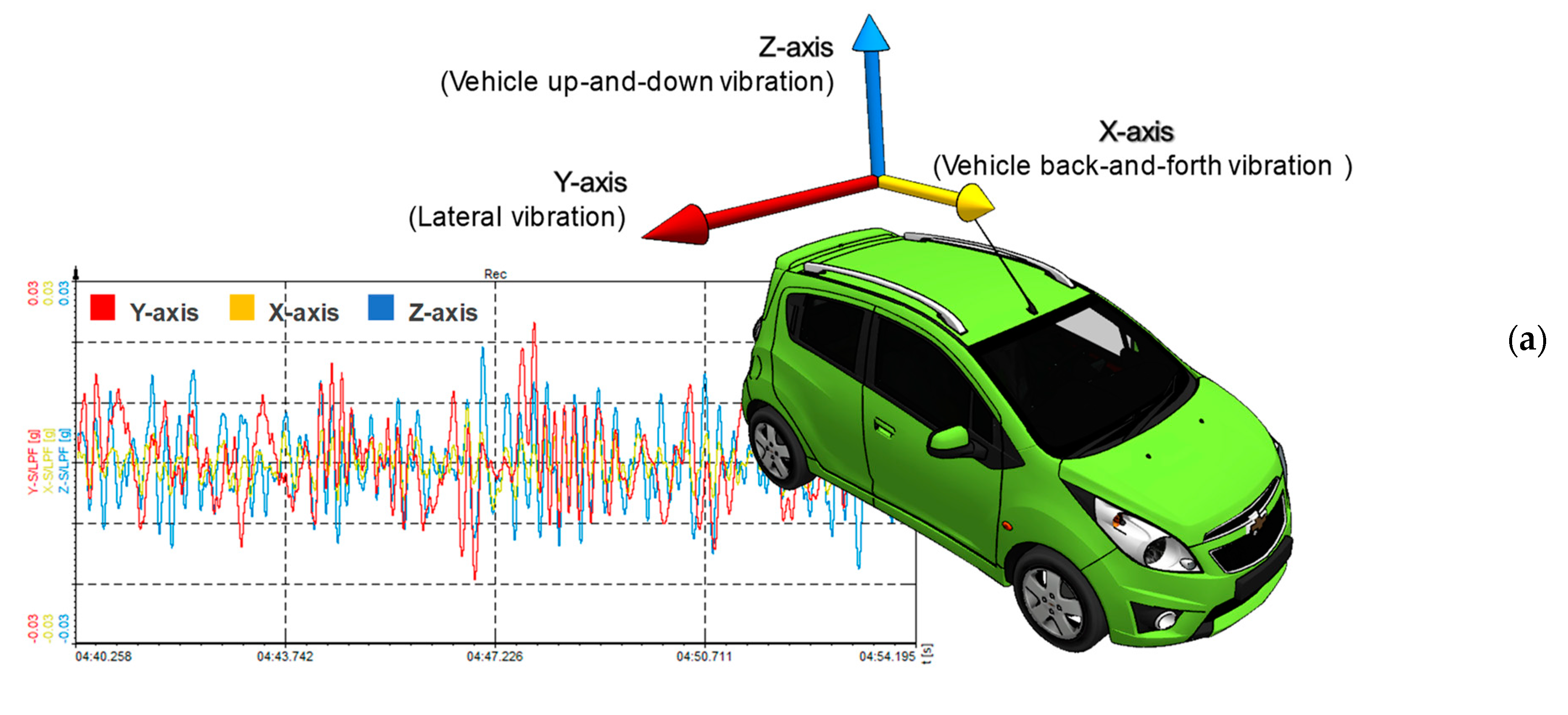
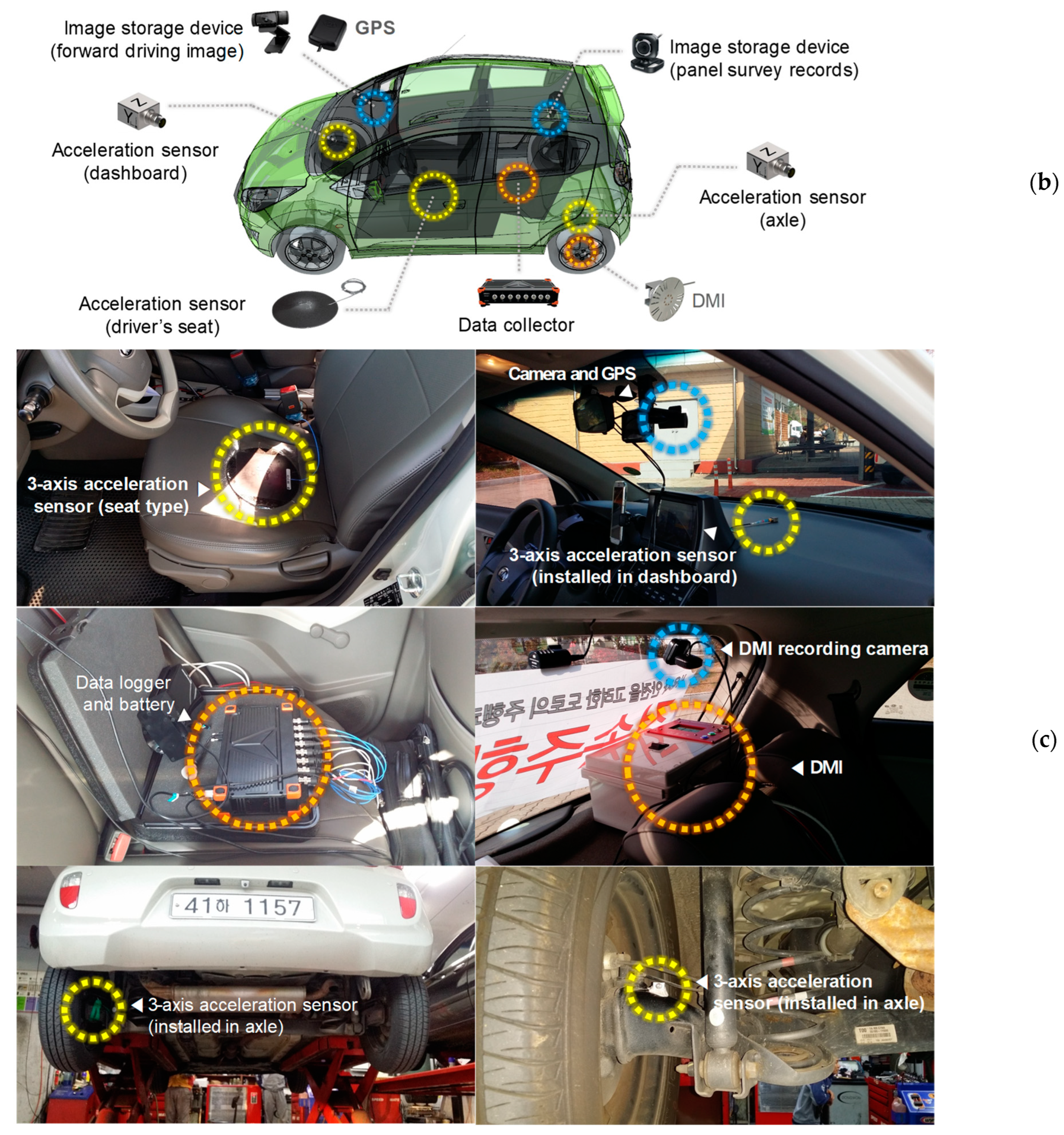
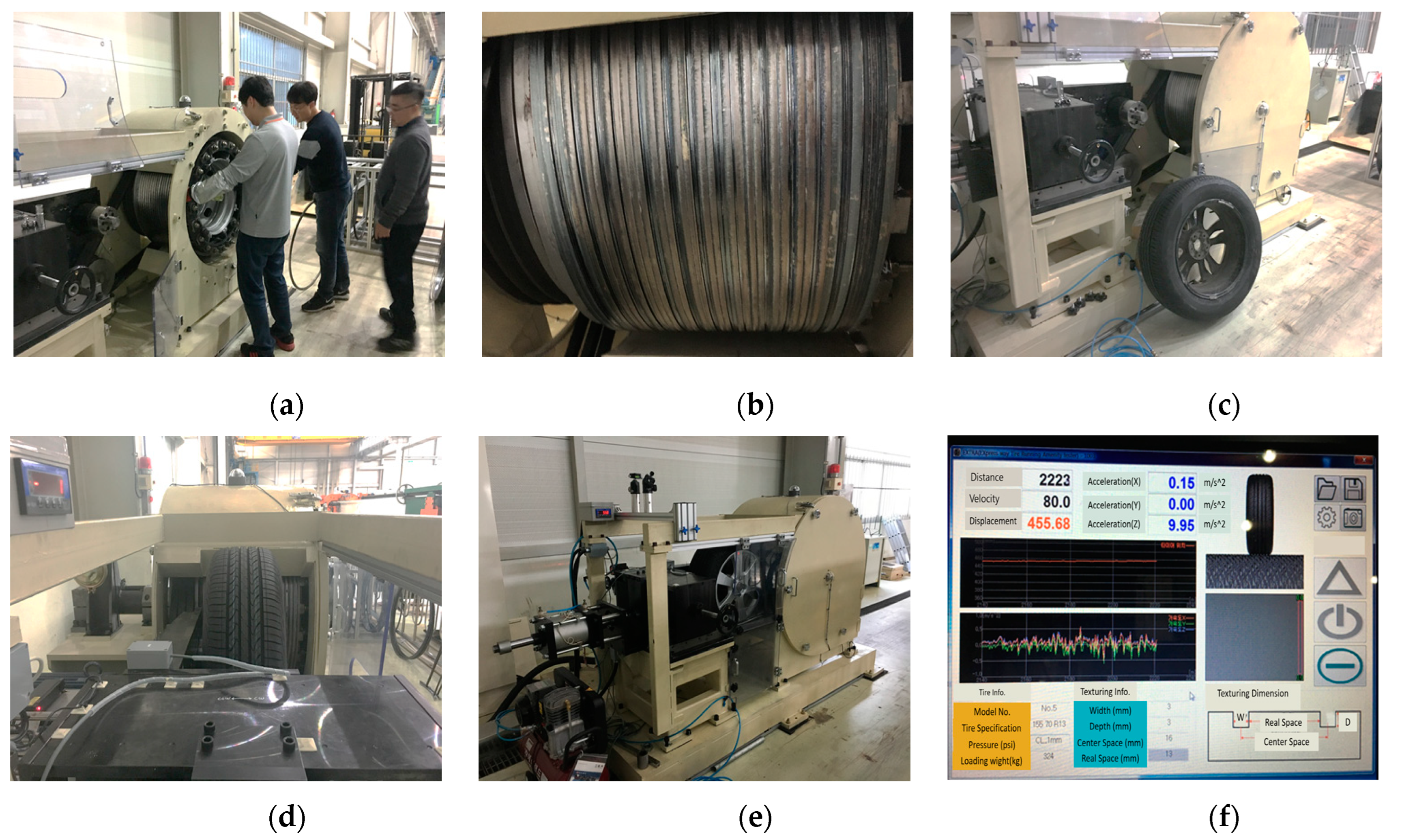
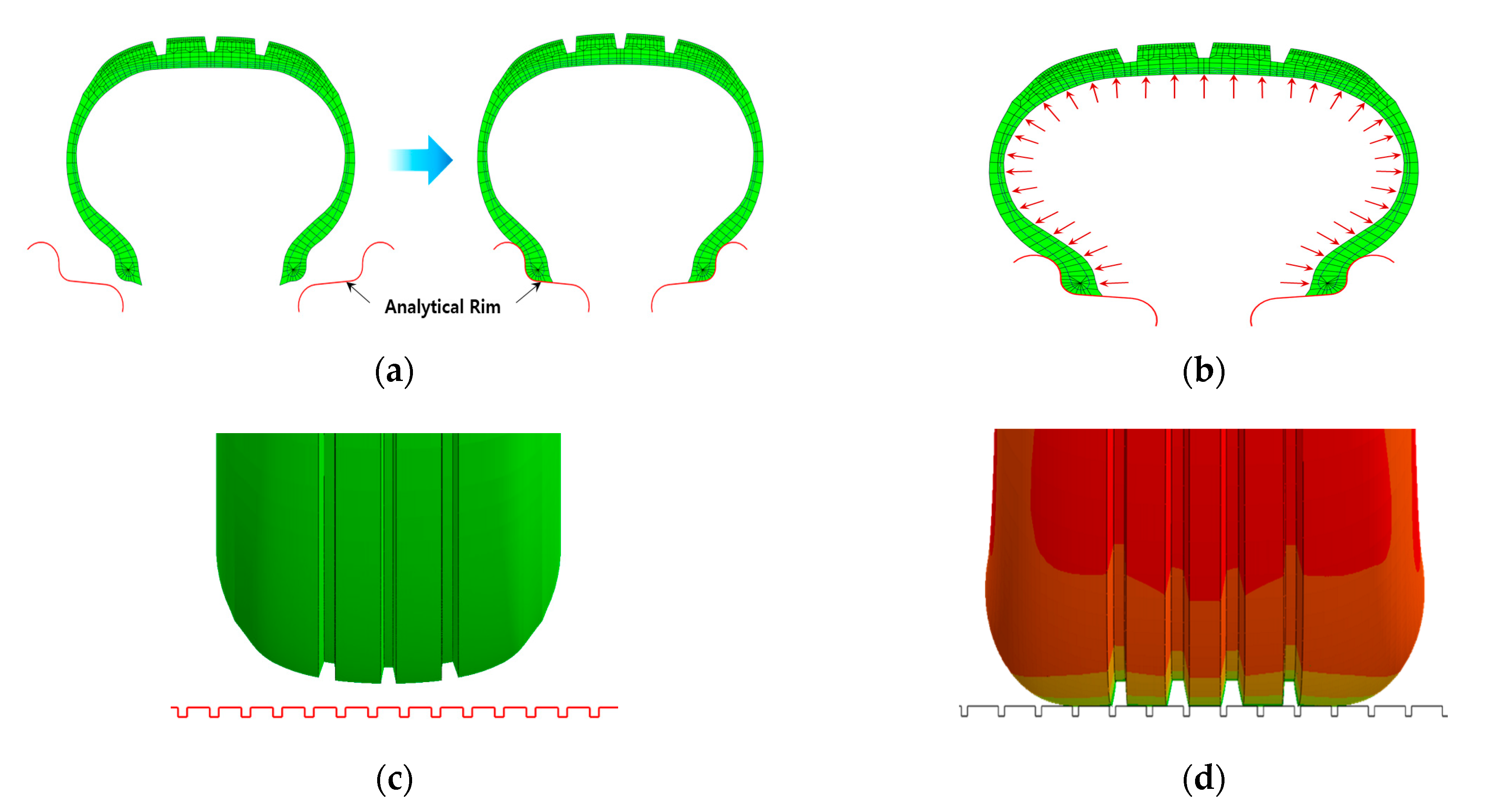
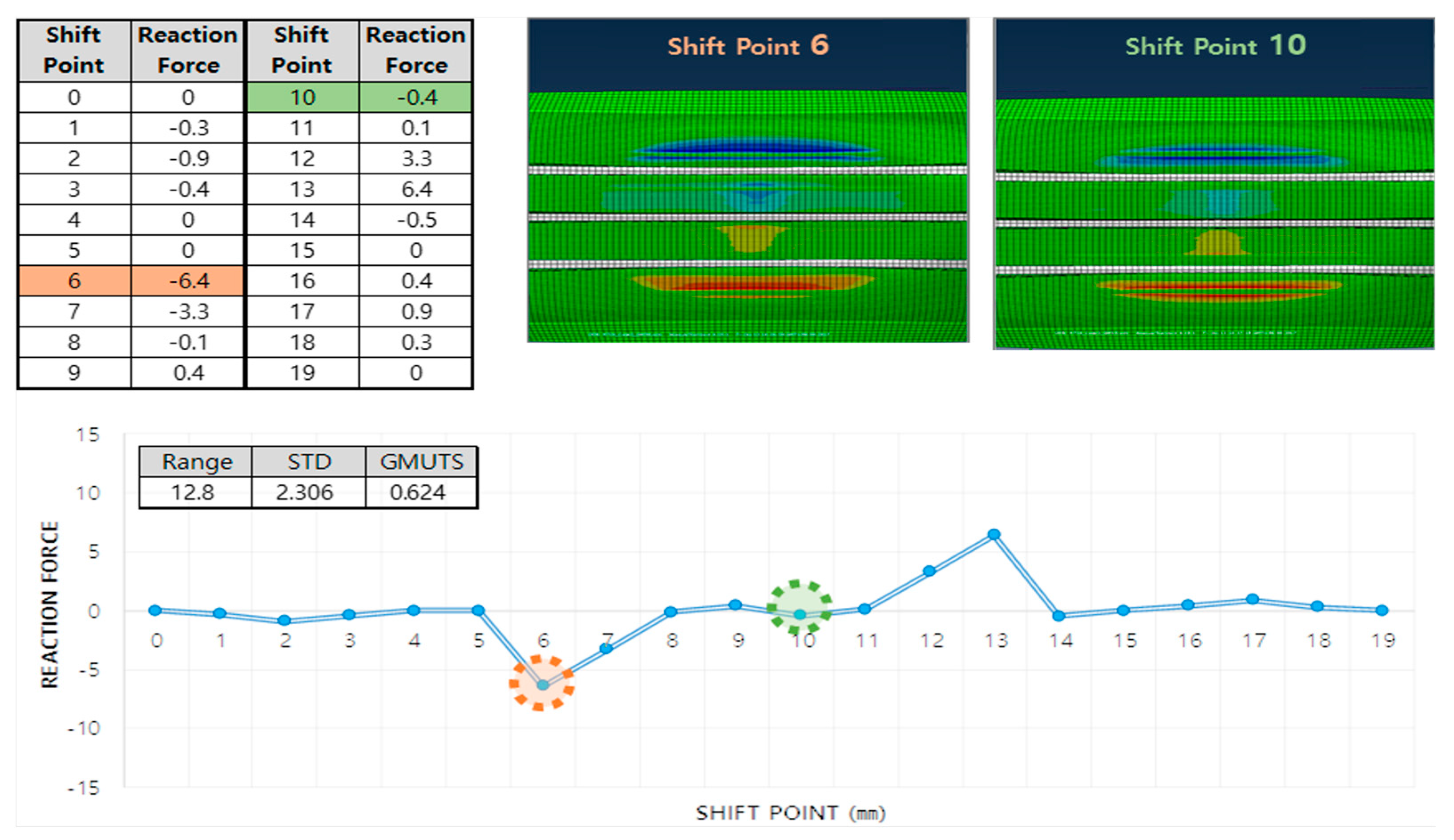
| Texturing Specification (mm) | Expressway | Section | Length (m) | Remarks | |
|---|---|---|---|---|---|
| Applied Time (Before/After Concrete Hardening) | Others | ||||
| 3 × 3 × 19 | Donghae | Sokcho-Yangyang | 1200 | Before hardening | KEC standard section |
| 3 × 3 × 16 | Dangjin-Yeongdeok | Test 2-2 | 930 | Before hardening | Test section |
| 4 × 4 × 14 (NGCS) | Pyeongtaek-Jecheon | Geumseong Tunnel | 4445 | After hardening | Complaints raised |
| Dangjin-Yeongdeok | Sailsan Tunnel | 2562 | |||
| Seoul-Yangyang | Hwacheon 9 Tunnel | 3705 | |||
| Seoseok Tunnel | 3061 | ||||
| Girin 6 Tunnel | 2665 | ||||
| Inje-Yangyang Tunnel | 10,962 | ||||
| Gyeongbu | Eonyang-Yeongcheon | 4400 | |||
| Busan Outskirts | Busan Outskirts | 1400 | |||
| 2 × 3 × 19 | Dangjin-Yeongdeok | Test 1 | 940 | After hardening | Test section |
| 2 × 3 × 16 | Dangjin-Yeongdeok | Test 2-1 | 940 | After hardening | Test section |
| 3 × 3 × Random | Central Inland | Yeoju-Yangpyeong | 1000 | Before hardening | Complaints raised |
| Name | Specification | Wheel Size | Test Vehicles | Manufacture Company | Tread Profile |
|---|---|---|---|---|---|
| Tire1 | 155/80 R13 | 13 inches | Small | A | 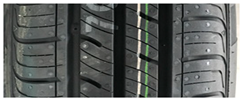 |
| Tire2 | 155/65 R13 | B | 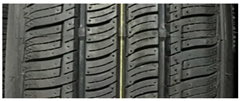 | ||
| Tire3 | 155/70 R13 | B | 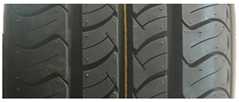 | ||
| Tire4 | 155/70 R13 | C | 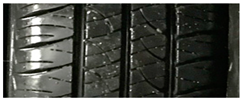 | ||
| Tire5 | 155/70 R13 | C |  | ||
| Tire6 | 235/60 R18 | 18 inches | SUV | A |  |
| Tire7 | 235/60 R18 | B | 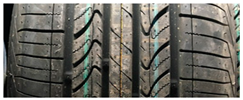 | ||
| Tire8 | 235/60 R18 | C | 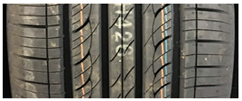 |
| Texturing Specification (mm) | Expressway | Section | Number of Data | Result of Applying the Lateral Vibration Tolerance |
|---|---|---|---|---|
| 3 × 3 × 19 | Donghae | Sokcho-Yangyang | 22 | 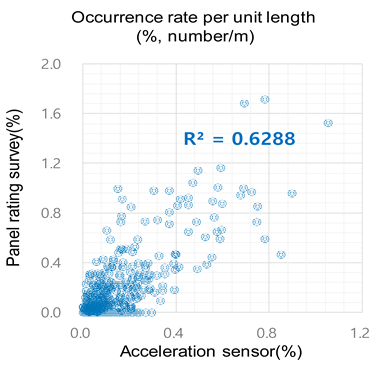 |
| 3 × 3 × 16 | Dangjin-Yeongdeok | Test 2-2 | 36 | |
| 4 × 4 × 14 (NGCS) | Pyeongtaek-Jecheon | Geumseong Tunnel | 71 | |
| Dangjin-Yeongdeok | Sailsan Tunnel | 76 | ||
| Seoul-Yangyang | Hwacheon 9 Tunnel | 4 | ||
| Seoseok Tunnel | 4 | |||
| Girin 6 Tunnel | 4 | |||
| Inje-Yangyang Tunnel | 24 | |||
| Gyeongbu Line | Eonyang-Yeongcheon | 4 | ||
| Busan Outskirts | Busan Outskirts | 12 | ||
| 2 × 3 × 19 | Dangjin-Yeongdeok | Test 1 | 36 | |
| 2 × 3 × 16 | Dangjin-Yeongdeok | Test 2-1 | 36 | |
| 3 × 3 × Random | Central Inland | Yeoju-Yangpyeong | 70 | |
| Total | 399 | |||
| Classification | Texturing Specifications | |||||||
|---|---|---|---|---|---|---|---|---|
| 3 × 3 × 19 | 3 × 3 × 16 | 4 × 4 × 14 | 2 × 3 × 19 | 2 × 3 × 16 | 3 × 3 × R | Average | ||
| Tire type | Tire1 | 0.000 | 0.013 | 0.066 | 0.000 | 0.000 | 0.273 | 0.352 |
| Tire2 | 0.000 | 0.000 | 0.122 | 0.000 | 0.018 | 0.164 | 0.304 | |
| Tire3 | 0.000 | 0.017 | 0.109 | 0.007 | 0.008 | 0.172 | 0.313 | |
| Tire4 | 0.000 | 0.000 | 0.287 | 0.000 | 0.000 | 0.141 | 0.428 | |
| Tire5 | 0.000 | 0.000 | 0.070 | 0.029 | 0.037 | 0.496 | 0.632 | |
| Tire6 | 0.000 | 0.000 | 0.043 | 0.000 | 0.000 | 0.000 | 0.043 | |
| Tire7 | 0.000 | 0.000 | 0.210 | 0.000 | 0.000 | 0.115 | 0.325 | |
| Tire8 | 0.041 | 0.000 | 0.178 | 0.000 | 0.076 | 0.026 | 0.321 | |
| Average | 0.007 | 0.004 | 0.136 | 0.004 | 0.017 | 0.173 | ||
| Classification | Texturing Specifications | |||||||
|---|---|---|---|---|---|---|---|---|
| 3 × 3 × 19 | 3 × 3 × 16 | 4 × 4 × 14 | 2 × 3 × 19 | 2 × 3 × 16 | 3 × 3 × R | Average | ||
| Tire type | Tire1 | 0.004 | 0.043 | 0.063 | 0.079 | 0.043 | 0.222 | 0.454 |
| Tire2 | 0.008 | 0.062 | 0.053 | 0.032 | 0.045 | 0.135 | 0.335 | |
| Tire3 | 0.016 | 0.024 | 0.053 | 0.014 | 0.022 | 0.235 | 0.364 | |
| Tire4 | 0.011 | 0.067 | 0.177 | 0.021 | 0.053 | 0.143 | 0.472 | |
| Tire5 | 0.046 | 0.096 | 0.032 | 0.029 | 0.040 | 0.167 | 0.410 | |
| Tire6 | 0.028 | 0.164 | 0.041 | 0.064 | 0.038 | 0.075 | 0.410 | |
| Tire7 | 0.012 | 0.203 | 0.172 | 0.033 | 0.070 | 0.158 | 0.648 | |
| Tire8 | 0.083 | 0.189 | 0.079 | 0.047 | 0.051 | 0.106 | 0.555 | |
| Average | 0.032 | 0.106 | 0.084 | 0.040 | 0.045 | 0.155 | ||
| Classification | Texturing Specifications | |||||||
|---|---|---|---|---|---|---|---|---|
| 3 × 3 × 19 | 3 × 3 × 16 | 4 × 4 × 14 | 2 × 3 × 19 | 2 × 3 × 16 | 3 × 3 × R | Average | ||
| Tire type | Tire1 | 46.2 | 24.2 | 48.3 | 43.6 | 12.1 | 83.2 | 40.8 |
| Tire2 | 43.6 | 21.2 | 37.9 | 33.3 | 12.1 | 82.4 | 35.5 | |
| Tire3 | 43.6 | 15.2 | 34.5 | 41.0 | 12.1 | 82.8 | 33.8 | |
| Tire4 | 51.3 | 27.3 | 24.1 | 38.5 | 12.1 | 82.8 | 35.4 | |
| Tire5 | 48.7 | 27.3 | 34.5 | 41.0 | 12.1 | 82.4 | 35.2 | |
| Tire6 | 46.2 | 18.2 | 48.3 | 51.3 | 24.2 | 83.6 | 43.6 | |
| Tire7 | 43.6 | 21.2 | 48.3 | 56.4 | 30.3 | 87.4 | 44.8 | |
| Tire8 | 43.6 | 51.5 | 44.8 | 53.8 | 24.2 | 84.5 | 47.7 | |
| Average | 45.8 | 25.8 | 40.1 | 44.9 | 17.4 | 83.6 | ||
| Classification | Texturing Specifications | |||||||
|---|---|---|---|---|---|---|---|---|
| 3 × 3 × 19 | 3 × 3 × 16 | 4 × 4 × 14 | 2 × 3 × 19 | 2 × 3 × 16 | 3 × 3 × R | Average | ||
| Tire type | Tire1 | 23.0 | 25.8 | 15.4 | 7.8 | 10.4 | 18.0 | 16.73 |
| Tire2 | 13.0 | 8.4 | 9.2 | 15.6 | 14.4 | 11.7 | 12.05 | |
| Tire3 | 34.4 | 8.4 | 33.8 | 12.0 | 19.8 | 20.8 | 21.53 | |
| Tire4 | 10.0 | 10.4 | 18.6 | 12.8 | 2.8 | 20.7 | 12.55 | |
| Tire5 | 21.8 | 22.4 | 12.6 | 9.0 | 14.4 | 26.3 | 17.75 | |
| Tire6 | 8.4 | 17.0 | 21.4 | 6.2 | 11.6 | 21.1 | 14.28 | |
| Tire7 | 25.0 | 8.2 | 15.2 | 6.8 | 4.2 | 23.7 | 13.85 | |
| Tire8 | 12.4 | 25.4 | 12.2 | 8.6 | 11.6 | 17.4 | 14.60 | |
| Average | 18.5 | 15.8 | 17.3 | 9.9 | 11.2 | 20.0 | ||
| Surface Specification | Panel Survey (Occurrence Rate, %) | Acceleration Data (Occurrence Rate, %) | Structural Analysis (Max Range) | Laboratory Driving Test (Probability, %) | Applied Time (Before/After Concrete Hardening) |
|---|---|---|---|---|---|
| 3 × 3 × 19 | 0.007 (1) | 0.032 (1) | 18.5 | 45.8 | Before hardening |
| 3 × 3 × 16 | 0.004 (2) | 0.106 | 15.8 (3) | 25.8 (3) | Before hardening |
| 4 × 4 × 14 | 0.136 | 0.084 | 17.3 | 40.1 (2) | After hardening |
| 2 × 3 × 19 | 0.004 (2) | 0.040 (2) | 9.9 (1) | 44.9 | After hardening |
| 2 × 3 × 16 | 0.017 | 0.045 (3) | 11.2 (2) | 17.4 (1) | After hardening |
| 3 × 3 × Random | 0.173 | 0.155 | 20.0 | 83.6 | Before hardening |
Publisher’s Note: MDPI stays neutral with regard to jurisdictional claims in published maps and institutional affiliations. |
© 2022 by the authors. Licensee MDPI, Basel, Switzerland. This article is an open access article distributed under the terms and conditions of the Creative Commons Attribution (CC BY) license (https://creativecommons.org/licenses/by/4.0/).
Share and Cite
Ryu, S.; Kim, J.; Sohn, D.; Bae, S. Optimal Longitudinal Texture on Concrete Pavement to Reduce Lateral Vibration of Vehicles. Appl. Sci. 2022, 12, 9661. https://doi.org/10.3390/app12199661
Ryu S, Kim J, Sohn D, Bae S. Optimal Longitudinal Texture on Concrete Pavement to Reduce Lateral Vibration of Vehicles. Applied Sciences. 2022; 12(19):9661. https://doi.org/10.3390/app12199661
Chicago/Turabian StyleRyu, Sungwoo, Jongho Kim, Duecksu Sohn, and Sungho Bae. 2022. "Optimal Longitudinal Texture on Concrete Pavement to Reduce Lateral Vibration of Vehicles" Applied Sciences 12, no. 19: 9661. https://doi.org/10.3390/app12199661
APA StyleRyu, S., Kim, J., Sohn, D., & Bae, S. (2022). Optimal Longitudinal Texture on Concrete Pavement to Reduce Lateral Vibration of Vehicles. Applied Sciences, 12(19), 9661. https://doi.org/10.3390/app12199661





